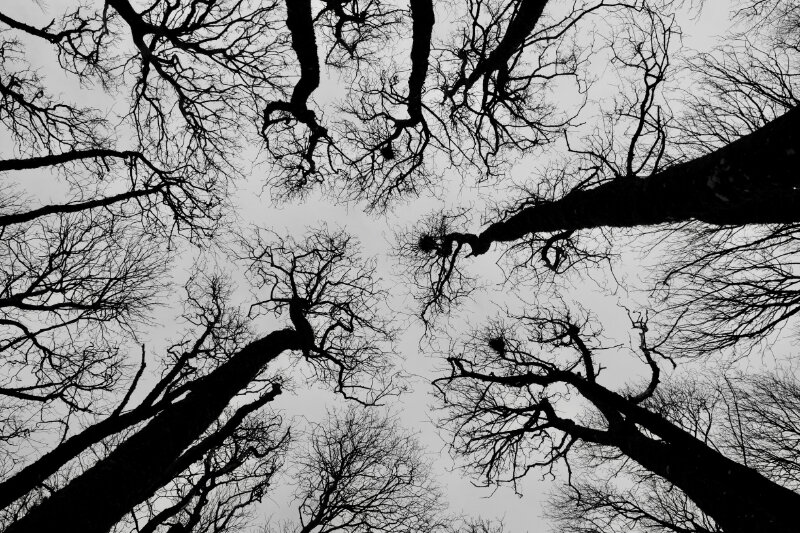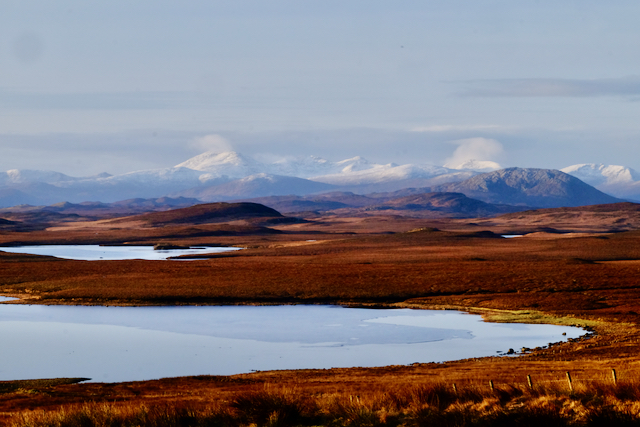
“There is little light in northern Scotland in mid-winter, and as we entered a new lockdown, everything seemed to get that little bit darker. Like most people, the freedom of the daily walk once again took on new significance as our worlds shrank back […] looking online for new places we could explore locally, I happened on Den Wood. The only Woodland Trust managed site in the North East of Scotland…”
From ‘Winter in Den Wood‘ – Elsewhere: a Journal of Place.
Three years on and Den Wood has become a semi-regular haunt. I like to visit throughout the year to see it in the changing seasons, feel the woodland in all its different atmospheres. I returned there again earlier this month – before storm Isha, before that brief covering of snow was swept clear by Isha’s warm Atlantic airmass.
Winter always feels special in the wood – still and redolent with potential; a place on the edge of happening. I felt slightly disoriented, set slightly off balance. A familiar wood had become strange to me again, its well-trodden pathways submerged in a layer of snow – a trail of ill-defined footprints twisting through the closely-packed, naked trees. The moon was out, a thumbprint in the pale ink of the sky, the sun dragging the last of the daylight through the tops of the branches.
I came eventually to a crown of wych elm that had first drawn me to the wood three years previous. Once commonly found growing at the sites of tumuli and barrows, elms have a long association with the underworld. In Celtic mythology elves lived amongst the trees, guarding the barrows and protecting the dead that lay within them, overseeing the passage between life and death. With the advent of Christianity, travelling priests would give sermon beneath their branches. Its wood was used to make coffins.
The word wych is not associated with witches, though both witch and wych can be used interchangeably. It is the old English for pliant or supple. Being resistant to rot, the same qualities that made it a suitable wood for coffin-making also made it a good choice for boat hulls and bridge foundations. In Gaelic the tree is known as leven, which can still be seen in some Scottish place names. Loch Leven in Perth and Kinross, where Mary Queen of Scots was imprisoned in its island castle, takes its name as a place where elm bark was used to make dyes for wool. Its inner bark was also boiled down to make a liquor, seen as a good medicinal cure for sore throats and colds. Despite the lack of any witch association, their long, broom-like branches extending up to thirty meters skyward definitely have a witchy air about them.
Survivors of disease, maker of coffins, of wool dye, of dogmas now long forgotten, their presence impressed upon me the nearness of something I find difficult to express: not a sacredness, as such, but an empathy, maybe – an empathy that seems to emerge out of their branches and extend out into the world. It leads me to think about that traditional false separation between the human and non-human, about the way all of life is threaded through, together – woven, as Tim Ingold writes, in a ‘domain of entanglement’.1
Where do the trees end and I begin? Where is the boundary between tree, roots, soil, air, my breathing and thinking and being? It is not just a hippy idea of ‘oneness’, this, a flaky new age folksy feeling that yes, we are all connected, but an intellectual, phenomenological and objective reality. Everything really is whole within the multitudinous, messy complexity of everything: this domain of entangled life and death we wrap ourselves in. The elms are me. I am the elms.
Is this some radical new thought? Not at all. We all know that everything is interdependent, and yet why don’t we live by it? Why don’t we live as though elm is me and I am elm? There is less than 3% of truly ancient woodland left in Britain. The rest has been replaced by agriculture, commercial forestry, urban development and transport networks. We need all these things, but we also need the trees. We need to find a way to get ourselves entangled again, play a little twister.
Cities around the world are beginning to take up this idea, perhaps not as I’ve put it, but in a way that attempts to meld human and nonhuman ecologies; the most famous of them being Singapore where the Gardens by the Bay project has blended the old distinctions between the city and the wild. In Glasgow too, there are efforts to intertwine nature and culture and economy for a greener city, with the Glasgow Doughnut concept.
The idea of the Glasgow Doughnut is a play on the doughnut economy idea developed by Kate Raworth, where human wellbeing and health is seen as being fundamentally connected to the health and wellbeing of the planet. The doughnut consists of two concentric rings: an inner ring that represents a social foundation where the needs of society are met within an outer ring that represents a known and measured ecological ceiling. Between these two rings is a zone that is both ecologically safe and socially just. Glasgow has followed the lead of cities like Amsterdam, the first to begin to practically take up Raworth’s concept in its recovery from the pandemic, and has commissioned a report recommending initiatives to help the city move toward a more entwined future that inhabits this space. If more and more cities take up this principal, we will live in a more socially just and environmentally sustainable world.
The more I have visited Den Wood, the more this idea has seeped into me – from the elms perhaps, from their winter canopy of witchy broom and their summer shade. Not only the White Letter Hair Streak butterfly relies on them. We do too. Those and all the other tree and plant species with all the ecologies their roots, branches and canopies contain. We need to make space for them. We need to make them part of our everyday lives, not just tucked away in parks and gardens, but part of the infrastructures we live by. We need to live with and through and not apart from. Elm is me and I am elm.
The sun dipped toward the lower branches and I trudged back through the snow between thickets of gorse and over fallen trunks. The wood would rot and become part of the woodland understory, supporting insects, beetles and worms, liverworts, mosses and lichens, enriching the top layers of the soil and allowing new growth. The moon rose higher ahead and the shadows deepened. I imagined myself part of the wood, asleep in the understory; come time, an elm growing where once I had lain.
- See Tim Ingold, ‘Part II: The Meshwork’ in Being Alive: Essays on Movement, Knowledge and Description (Abingdon, Oxon: Routledge, 2011), pp. 63-94.

